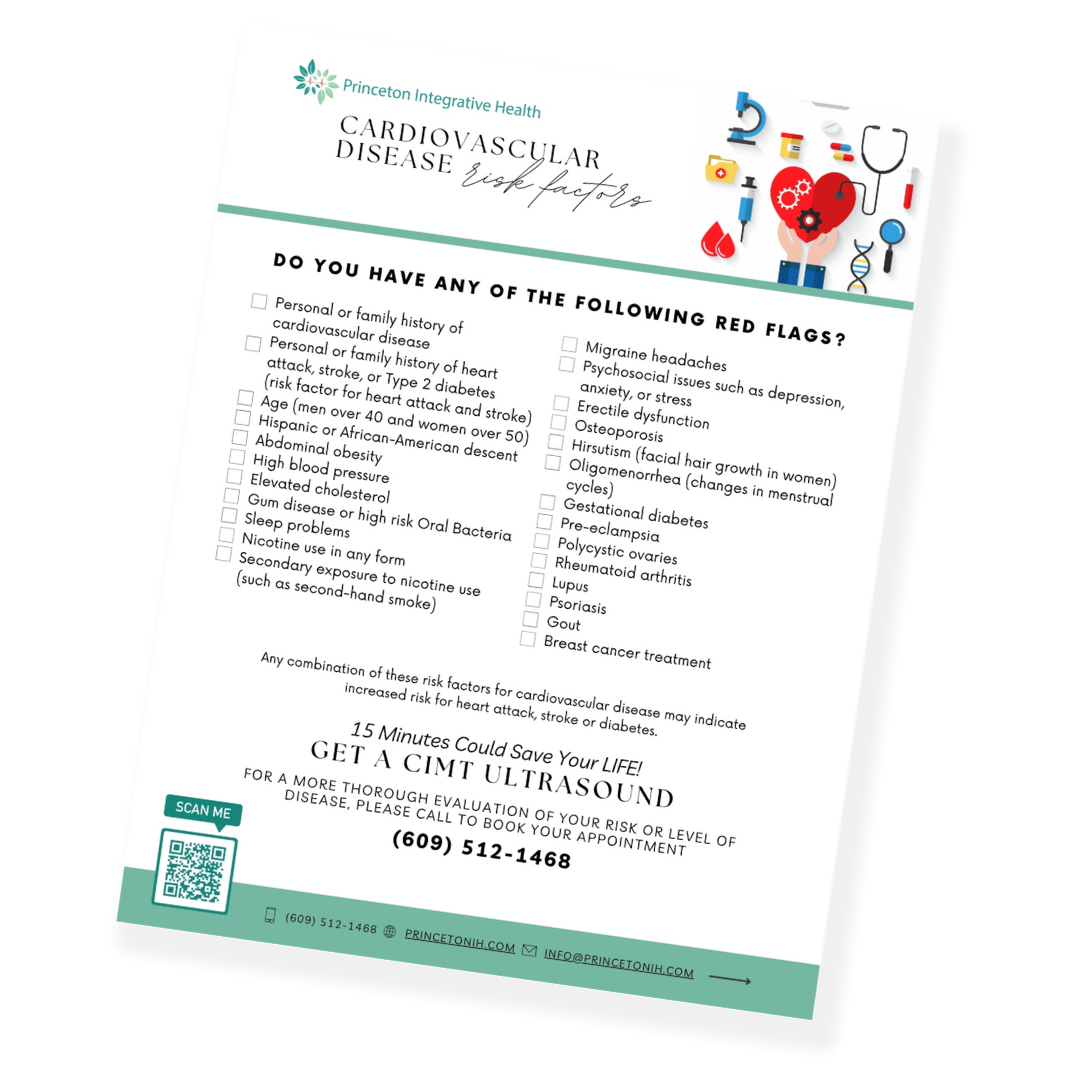While our medical system has trained specialists, i.e., cardiologists for the heart, neurologists for the brain and so forth, no one has claimed responsibility for the arteries which include over 30,000 miles of pathways that carry blood to all the critical areas of the body. Our specialties are trained to react with an event occurs but have not been trained to ensure that the arteries are free from inflammation and disease.

Why we use the BaleDoneen Method.
The BaleDoneen Method is a science-based methodology that is medically proven and accepted to both prevent and reverse heart attacks, strokes, and many other chronic conditions such as type 2 diabetes, dementia, kidney disease, and erectile dysfunction to name a few.
The cure for arterial disease...
The BaleDoneen Method is focused on the specialty of arteriology. It uses advanced laboratory and imaging tests and a comprehensive, individualized
assessment to check each patient for hidden signs of arterial disease or red flags signaling increased risk for developing cardiovascular disease (CVD). The goal of the BaleDoneen Method is to find out if patients have arterial inflammation and if so, apply individualized treatment to extinguish inflammation to halt its progression with genetically guided, evidence-based therapies. Our method is based on six dynamic elements, each of which is crucial for detecting and defeating cardiovascular disease.
EDUCATION Understanding what causes heart attacks and strokes, plus the action steps needed to prevent these catastrophic events, empowers the patients to make choice that lead to recovery and wellness.
DISEASE Identifying which patients have disease (plaque) in the arteries is essential since this is a prerequisite for an event. Treatment decisions should be based on this infuriation and disease monitored over time.
FIRE Events are sparked when disease becomes inflamed. Think of plaque as kindling. Inflammation lights the match, causing the plaque to rupture explosively. We use a “fire panel” of tests to detect and monitor inflammation.
ROOTS To put out the fire in a patient’s arteries, it’s essential to identify and treat the cause. Without this knowledge, the disease frequently smolders until there is another event. Using techniques perfected by the BaleDoneen Method, we can determine the root causes and halt the disease.
OPTIMAL Setting optimal, individualized goals for modifying each patient’s risk factors leads to superior outcomes and more effective heart attack and stroke prevention.
GENES Basing care on each patient’s unique genetic makeup is the ultimate in precision medicine. The BaleDoneen Method has used genetic testing for more than a decade and remains on the cutting edge of this rapidly evolving field of medicine.

Dr. Vincent Leonti, MD
Cardiovascular care at PIH is delivered from the heart by Dr. Vincent Leonti, M.D. and certified in the BaleDoneen Method, a Heart Attack and Stroke prevention program. If you are at increased risk or have heart disease, Dr. Vinny's root cause approach will allow you to go from hope to healing to living your life to the fullest.
FAQs
Yes! It is a science-based methodology that is medically proven and accepted to both prevent and reverse heart attacks, strokes, and many other chronic conditions such as type 2 diabetes, dementia, kidney disease, and erectile dysfunction to name a few.
The BaleDoneen Method uses advanced laboratory and imaging tests and a comprehensive, individualized assessment to check each patient for hidden signs of arterial disease or red flags signaling increased risk for developing cardiovascular disease (CVD).
Peer-reviewed studies have shown that our evidence-based, precision-medicine approach can halt, stabilize or reverse CVD, helping patients avoid heart attacks or strokes, even if they’ve already suffered one or more of these events.
The goal of the BaleDoneen Method is to find out if patients have arterial inflammation and if so, apply individualized treatment to extinguish inflammation to halt its progression with genetically guided, evidence-based therapies. Our method is based on six dynamic elements, each of which is crucial for detecting and defeating cardiovascular disease.

Advanced Lipid Testing
from Cleveland Heart Diagnostics
A standard lipid panel alone may not predict your true risk for cardiovascular disease.
To gain a more comprehensive look at your risk, we recommend advanced, specialized testing for some patients, particularly those with risk factors, to evaluate lipids, inflammation, metabolics, and genetics.
Recent studies show that lowering your LDL cholesterol reduces your risk for a cardiovascular event by only 25 percent, and at least half of people who have experienced a cardiac event had cholesterol levels in the “normal” range.
Know your risk.
Cleveland HeartLab Testing offers advanced lipid testing to aid in determining cardiovascular risk in patients, alongside a Standard Lipid Panel which is commonly performed at least once a year in most medical practices. While a Standard Lipid Panel provides cholesterol and triglyceride measurements, other measurements readily available can address additional risk factors for disease including the number of atherogenic particles, the size of these particles and the inherent risk of developing CVD.
HDL cholesterol particles are considered to be cardioprotective because of their anti-atherogenic properties, which include increasing reverse cholesterol transport, promoting endothelial nitric oxide production, and anti-inflammatory and antithrombotic effects. Low HDL-C, a component of metabolic syndrome, is predictive of cardiovascular risk, but clinical trials have shown therapeutically increased HDL-C levels do not reduce rates of cardiovascular events. These findings led to an understanding that the physiological impact of HDL may be dependent on its functionality, more so than low or high HDL-C levels. The importance of HDL function to CVD is highlighted by findings that patients who have the highest cholesterol efflux capacity (CEC), a marker of HDL function, have a 67% reduction in cardiovascular risk compared to the lowest quartile CEC.
Evaluation of lipoprotein particles has been used to support management of cardiovascular disease (CVD) risk for over 15 years, and lipoprotein subclass analysis has become a valuable tool to help clinicians better stratify patients at risk. In situations where LDL-C or HDL-C levels determined as part of a conventional lipid panel are optimal, additional LDL-C and HDL-C subclass analysis may identify patients with increased CVD risk. Enhanced identification of these previously unidentified at-risk patients can help physicians incorporate treatment that can help reduce atherosclerotic CVD and significantly reduce cardiovascular events.
ApoB is the primary apolipoprotein found on the surface of LDL (the carrier of “bad” cholesterol), IDL (intermediate-density lipoprotein), VLDL (very low-density lipoprotein) and Lp(a) (lipoprotein (a)). ApoB acts as a ligand for LDL receptors on various cells throughout the body thereby regulating cholesterol influx into tissues. ApoA1 is the major apolipoprotein of HDL (the carrier of “good” cholesterol) and promotes cholesterol efflux from the artery wall to the liver for excretion.
LDL, which carries “bad” cholesterol, exists either as large, more buoyant particles or as smaller, more dense particles (sdLDL). sdLDL is more easily oxidized, has a higher affinity for vessel walls, and remains in the circulation longer because it is less likely to be cleared by the liver, making it more atherogenic than larger LDL particles.

Carotid Intima Media Thickness Testing (CIMT)
A groundbreaking technology that can save lives.
CIMT measures the quantity and quality of plaque in the intima-media layers of your carotid artery, providing a comprehensive assessment of your cardiovascular health.
-
AGING
- ✔
-
HIGH CHOLESTEROL
- ✔
-
HIGH BLOOD PRESSURE
- ✔
-
SMOKING
- ✔
-
DIABETES
- ✔
-
OBESITY
- ✔
-
AGING
- ✔
-
HIGH CHOLESTEROL
- ✔
-
HIGH BLOOD PRESSURE
- ✔
-
SMOKING
- ✔
-
DIABETES
- ✔
-
OBESITY
- ✔
Risk factors...
There are a number of known risk factors for cardiovascular disease — “red flags” — that may indicate an increased risk of heart attack, stroke, or diabetes.
A CIMT ultrasound offers valuable insights into inflammatory markers, giving you a complete understanding of your cardiometabolic health and your risk of Cardiovascular Disease (CVD).

You may also like...
Empowered Health Concierge Program
An ideal program for health-seeking clients + patients who are looking for direction and guidance with true practitioner partners on the journey toward optimal health.
HBOT
Providing oxygen to cells in need, aiding in energy generation, healing promotion, and toxin removal. With around 100 recognized conditions, HBOT has shown potential in supporting healing processes.
FX 405 for Chronic Pain
An FDA-approved solution for chronic neck, shoulder, and lower back pain. By stimulating cellular energy production, FX 405 promotes natural healing without surgery, downtime, or side-effects. Plus, it's completely non-invasive!
